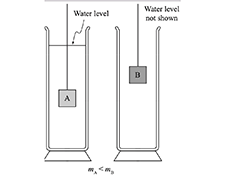
Buoyancy
Variant i Dynamics first
Students use the linear variation of pressure with depth to find that the net force by a fluid doesn't depend on depth/object mass and relate it to the weight of fluid displaced.
Topics Fluid mechanics / Hydrostatics: models, representations, atmospheric pressure, and pressure
Materials
Materials by the UW team
- Instructor Guide


- Pretest


- Exam Questions



- Equipment List

Tutorial details
In Section I of the tutorial, students consider a cubical block that is known to float in water. They are told that the block will be held in the center of a beaker of water and then released and are instructed to draw a free-body diagram for the block at the instant it is released. The students are directed to indicate the forces exerted by the water on the individual faces of the cube. They are then guided to use their knowledge of the depth dependence of pressure to conclude that the downward force on the upper surface is smaller in magnitude than the upward force on the lower surface. The students are then asked to indicate the direction of the vector sum of these forces and to compare its magnitude to the weight of the block. They are expected to recognize that the vector sum of the forces exerted by the water is directed upward and that in this case it must be greater than the weight of the block.
Students are then guided in applying a similar analysis to a block of the same volume that is known to sink. They are led to conclude that the forces exerted by the water on the surfaces of this block are the same as for the previous block and that the different behavior of the blocks can be accounted for by a difference in weight alone.
The students then consider how their free-body diagram would differ if the block were released from a much greater depth. They are expected to recognize that the forces exerted by the water are all greater in magnitude. They then are asked whether the difference between the forces exerted on the top and bottom surfaces has changed. A hint suggests they consider the difference in pressures. At this point the term ‘buoyant force’ is introduced for the vector sum of the forces exerted on an object by the surrounding fluid. The students are asked to summarize their conclusions about whether this force depends on the weight, depth, or volume of a completely submerged object. They are asked to check their answers before proceeding.
Section II of the tutorial deals with displaced volume. The activity is similar to the one in Physics by Inquiry described above. Section III begins with a statement of Archimedes’ Principle. The students are asked to evaluate a statement by a fictional student who claims that this principle implies that the weight of the liquid displaced by an object is equal to the weight of the object itself.
Section IV deals with sinking and floating. Students are asked to consider a situation similar to that at the beginning of the tutorial. They consider the forces exerted on a block that is known to float at an instant after it has been released underwater and when it is floating freely. They are asked to compare the magnitude of the buoyant force to the weight of the block in both cases. (A hint suggests that they think about the net force.) Finally, the students are asked if their answers are consistent with Archimedes’ Principle. They are expected to recognize that the greater buoyant force exerted on the block while submerged (which causes it to accelerate to the surface) is consistent with the greater volume the block displaces while submerged.
The block in the previous exercise is depicted as barely floating. In the final exercise, the students consider a block of slightly greater mass that is also released underwater. A dialogue is presented in which two fictional students argue that because the weight is greater than in the previous case, the block will rise, but not all the way to the surface. The students are asked to identify what is wrong with this argument.
For instruction tips, login or register as a verified educator to see the Instructor Guide.
Prerequisites
Familiarity with the depth dependence of pressure in an incompressible liquid, and of the relationship between force and pressure is assumed. The ability to draw free-body diagrams would be an asset.
Coming Soon! We hope to release the discussion section on each tutorial soon.

